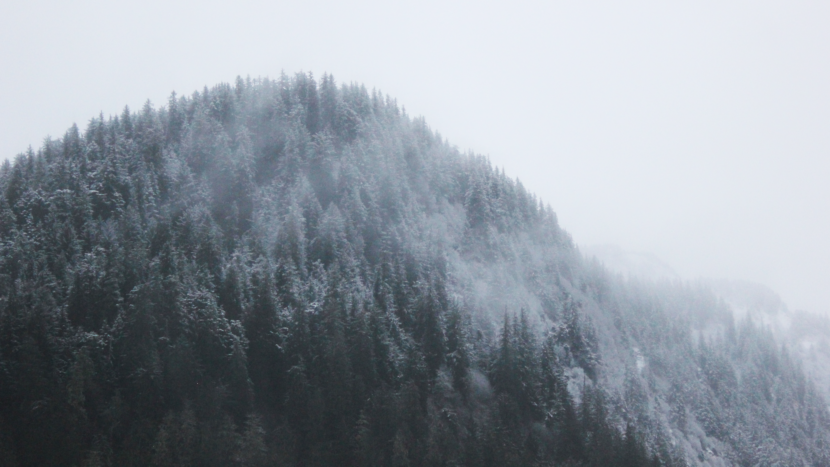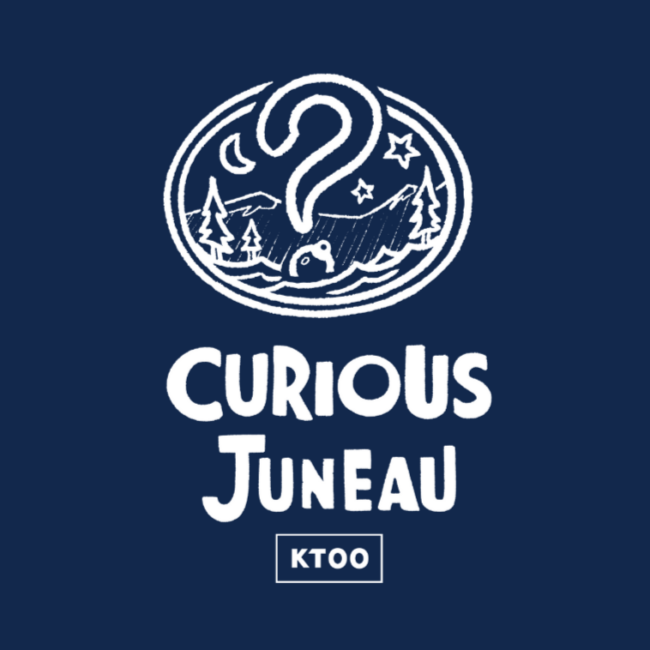
Anywhere you go in Juneau, there are mountains shooting up all around. Mt. Juneau and Mt. Roberts loom over downtown. Across the channel, Mt. Bradley – better known as Mt. Jumbo – notoriously blocks South Douglas from getting much sun. And in the valley, there’s Thunder Mountain — supposedly named for avalanches rumbling down its slopes.
A listener asked KTOO what the local mountains’ original Lingít names are. For this installment of Curious Juneau, Yvonne Krumrey spoke with Lingít educators to find out.

Like most of Juneau, Kristen Rankin likes to hike. On some of those hikes, she started wondering what some of her favorite peaks were called, before they were named after settlers.
“I love to be up on all of the mountains around us,” she said. “And I think it’s really important to know those names, and I want to. I want to feel connected with the land and the history.”
When she was thinking about that history, she couldn’t help but see how names like Mt. Juneau have only been around for a short time.
“We have these names that have been in existence for places for what — 150 years tops,” Rankin said. “And then there are the names for places, that these names have been around for thousands of years.”
University of Alaska Southeast Lingít Language Professor X̱’unei Lance Twitchell says, from a Lingít perspective, the newer names don’t make much sense.
“Imagine if your grandmother was 98 years old, and her name was Nora, and I met her and I started calling her Sally. And then you say, ‘Hey, my grandma’s name is actually Nora.’ And if my response is, ‘I’ve been calling her Sally for like a week now.’ And if that’s my response, to just keep calling her by a different name, then it sounds kind of silly,” Twitchell said. “But from a colonial perspective, people say ‘It’s been called that for, like 100 years.’ And so 100 years compared to 18,000 is not a very significant amount of time.”
And the staying power of these men’s names isn’t just a coincidence, he said.
“What you have behind that is erasure of Indigenous peoples,” Twitchell said.
A Lingít tour of Juneauʼs peaks
(Click on words in gray boxes to hear their pronunciation)
Twitchell said there are much older names for these mountains. Let’s take a tour, starting with the one the tram goes up. That one has mostly been called Mt. Roberts over the last century or so.
“Starting a little towards Thane there’s a place called Wooshkeenax̱ Deiyí,” he said. “And Wooshkeenax̱ Deiyí is ‘trails going up together.’”
And the one that now shares Juneau’s name?
“Coming over this way, Yadaa.at Kalé,” Twitchell said. “If you’re standing kind of right outside these studios and looking up towards the mountains that are kind of to the left of downtown, that’s Yadaa.at Kalé.”
You might recognize Yadaa.at Kalé as the name of the high school, which makes sense, since it faces the school. That name means “beautifully adorned face.” But that’s just the name of the face of Mt. Juneau — the top has a different name.
“Then if you look up from the high school, there is a mountain with a bit of a rounded top,” Twitchell said. “And that is Shaa Tlaax̱, and Shaa Tlaax̱ is a moldy head.”
And in the Mendenhall Valley, there’s the one that most of us call Thunder Mountain.
“Tleix̱satanjín is the one in between Costco, and the Valley over there,” he said. “And so Tleix̱satanjín is ‘hands at rest.’”
Then on South Douglas, there’s Mt. Bradley – though it’s mostly known as Mt. Jumbo.
“If you were standing here, downtown you look across, then there’s a mountain on the other side, on the big island over there,” Twitchell said. “It’s called Sayéik.”
Sayéik means “spirit helper,” and it’s also part of the name for the elementary school in Douglas. Twitchell said he knows the language is a learning curve.
“As we sort of use these names more, we shouldn’t be afraid of making mistakes,” he said. “And so some people are gonna say Sah-YEEK, as opposed to Sayéik. And that’s not a big deal.”
He said with gentle corrections, the right pronunciations will come with time.
‘You should always be working to learn to be an Indigenous person of the world.’
If you want to learn, there are classes you can take. Neelaatugha Anna Clock is a local Lingít language teacher. She’s Koyukon Athabascan and Eyak, so she learned the language as a visitor on Lingít land.
“Indigenous place names often describe the landscape or how to survive on it, how it can be useful to you, what to watch out for there — whereas colonial place names are often named after a person of power or wealth in a faraway land, because settlers wanted to honor that person if they funded their trip or whatever,” she said.
Clock said the Lingít language community is full of resources that can help people who live in Juneau to learn more about the land through language. She said she sees it as a vital part of getting to know this place.
“Having traditional stories, to read and listen to, and then having the language community was a big part for me of understanding and feeling like I belong there — even though I’m not of Lingit heritage, but I belonged there as a student,” she said.
One of Clock’s mentors, Marie Olson, an Áak’w Ḵwáan elder, gave Clock some advice that informed how she thinks of her language journey and her role in the world around her.
“One of the things she told me was, ‘You should always be working to learn to be an Indigenous person of the world,’” Clock said.
‘Now it’s time to do this with the land itself.’
Twitchell said that for most of these place names, it’s not a matter of changing a name to a Lingít one, but changing it back to what it was called before settlers came.
“When we look at place name restoration, we’re not looking at changing things so much as saying it never should have changed in the first place,” he said. “We were here, we belong. The land belongs to us, we belong to the land. And this relationship is not something that anyone had a right to remove.”
Language learners are scrambling to record as many place names as possible, he said. It’s a race against time because the number of elders who hold that knowledge dwindle each year. There are just seven master speakers now.
But, he said, there’s room for new place names too.
“It’s a living language,” Twitchell said. “And we could make new names as new things emerge, or as we find places where we couldn’t document those names in time. But we can make some names based on the knowledge that we have of this area.”
And, Twitchell said, mountains and valleys are a great place to start.
“We’ve done this with some schools, and that’s been effective. Now it’s time to do this with the land itself,” he said.
He said he believes in a future where everyone living here won’t think twice about saying they’re going for a hike up Wooshkeenax̱ Deiyí, or that their kid goes to school at Kax̱dig̱oowu Héen.
Curious Juneau
Are you curious about Juneau, its history, places and people? Or if you just like to ask questions, then ask away!
